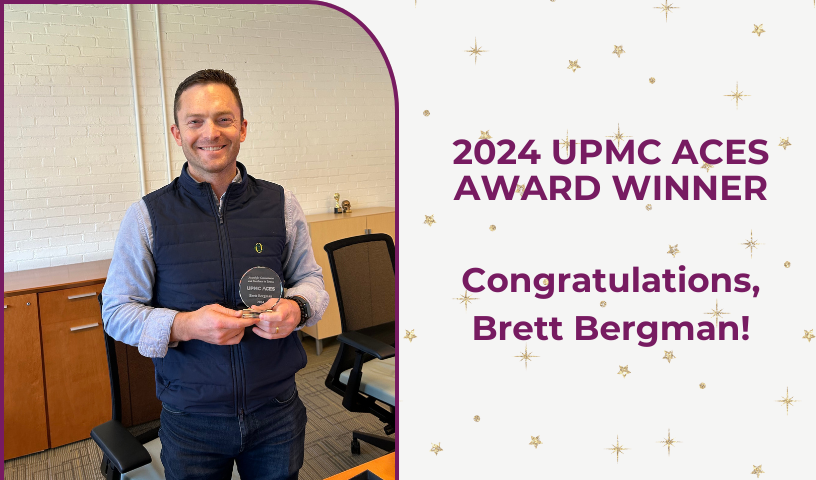Apr 3, 2018
What is the ‘Year of the Pipeline’ and what does it mean for UPMC Enterprises?
If you attended the March All Hands meeting you heard UPMC Enterprises President Tal Heppenstall refer to “The Year of the Pipeline” during his presentation on the BSI domain. If you weren’t at the meeting, you’ve probably heard the pipeline mentioned or seen an email talking about it.
So, what does Tal mean when he says it’s the year of the pipeline at Enterprises? To get all the answers, we went straight to the source and asked Tal a series of questions about the project.
Read on to hear his answers to what the pipeline is, why we have one, what changes are in store, and whom it affects.

Why do we need a pipeline?
It’s a standard practice in the industry for institutions like ours because it allows us to track the opportunities we’ve reviewed or the leads that need to be reviewed. A pipeline tool can track and measure the movement of opportunities through our stages from 0 to 4, or initial lead to commercialization. This process will help us to better determine how fast we’re making decisions to reject opportunities or how quickly we’re moving promising opportunities through our stages toward successful commercialization, or strategic partnership.
The other thing a pipeline creates is stronger intra-organizational visibility. If everyone is using the same software and the same process departments, domain teams and others have better visibility into what everyone else is doing. And that reduce inefficiencies. It makes the sharing of knowledge easier when it comes to what we’ve looked at, what the status is, and who’s responsible.
It also allows us to expose opportunities to our shared services and engineering teams, who aren’t as tied to this process. With a robust pipeline tool, they will be able to get up to speed on opportunities without needing to track down project leads. Done correctly it can improve engagement for everyone in the organization.
And finally, it allows for us to connect opportunities to our mission and specific goals. If we set goals across the enterprise or within domains, the use of the Pipeline will allow us to measure activities against those goals.
What are the different stages?
The stages range from zero to four. Although there is some overlap between the stages, the general descriptions are below.
- Stage Zero: Initial lead – an initial opportunity has been presented and entered into the Pipeline.
- Stage One: Early-stage vetting – the opportunity is evaluated at a high level to determine whether or not the opportunity has any interest or support within UPMC, and if the opportunity is valid.
- Stage Two: Early Evaluation – the opportunity is investigated as to strategic fit with UPMC, basic due diligence is conducted on the company and product and or service.
- Stage Three: Pilot or Trial – the opportunity is tested or explored for fit within the UPMC environment for validation, internal resources are deployed.
- Stage Four: Commercialization – a company is formed, or a project has a customer.
Can an opportunity skip stages or move backwards?
For internal projects, they usually progress along this process. External opportunities are more likely to enter at any stage.
Who does this affect?
Primarily it affects domain teams. They track opportunities with greater resolution and higher fidelity, which may create new workflows. But it really only refines and builds on work the domains are already doing.

When will all these changes happen?
The changes have started. We rolled out a revision to the Pipeline (hosted on Dynamics) in January, and a second revision was released in late March. This latest update will enable us to take the information from the Pipeline to create monthly opportunity reports.
The latest revision not allows for more detailed updating of opportunities, but it also better distills the key information at the top, which makes it easier for users to quickly get what they need. While not everyone at Enterprises will have access to the Pipeline, each department will have at least one person who can access and share information.
There will be continuous improvement this year to better refine our process, and support our goals and users. I encourage anyone with questions, suggestions or feedback to reach out to Rob Hartman, who is leading this project.
What will this initiative mean to Enterprises a year from now?
By end of 2018 the goal is to have greater visibility into our performance. That means tracking and measuring how many opportunities we actually looked at, what were the graduation rates from one stage to the next, seeing where there are intersections between domains, and where opportunities overlap, converge or cluster.
This measurement is key to the future of Enterprises as we align our activities to our goals in a disciplined way, and better engage with employees and stakeholders outside of Enterprises.
It’s important that we create not only within our growing team at Bakery Square but that we also build and maintain strong relationships with other parts of the broader UPMC organization. This should allow us to tap into UPMC’s institutional knowledge base to focus on the opportunities that line up with the strengths of UPMC. If we pursue opportunities that align both with what the market is telling us and where UPMC has expertise and is a differentiator, then our opportunities have the best chance of success. By better aligning what we do with where UPMC is delivering life changing medicine, our commercial efforts will be in position to win in the market.


